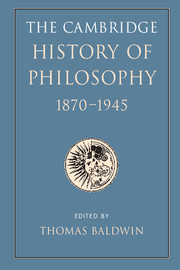Book contents
- Frontmatter
- Contents
- List of contributors
- Introduction
- I 1870–1914
- 1 Positivism, Idealism, and Pragmatism
- 2 Psychology and Philosophy
- 3 Logic, mathematics, and judgement
- 9 Logic: revival and reform
- 10 Foundations of mathematics
- 11 Theories of judgement
- 12 The logical analysis of language
- 4 Philosophy and the new physics
- 5 The idea of social science
- 6 Ethics, politics, and legal theory
- 7 Philosophy of religion and art
- Interlude
- II 1914–1945
- Biobibliographical appendix
- Bibliography
- INDEX
- References
11 - Theories of judgement
from 3 - Logic, mathematics, and judgement
Published online by Cambridge University Press: 28 March 2008
- Frontmatter
- Contents
- List of contributors
- Introduction
- I 1870–1914
- 1 Positivism, Idealism, and Pragmatism
- 2 Psychology and Philosophy
- 3 Logic, mathematics, and judgement
- 9 Logic: revival and reform
- 10 Foundations of mathematics
- 11 Theories of judgement
- 12 The logical analysis of language
- 4 Philosophy and the new physics
- 5 The idea of social science
- 6 Ethics, politics, and legal theory
- 7 Philosophy of religion and art
- Interlude
- II 1914–1945
- Biobibliographical appendix
- Bibliography
- INDEX
- References
Summary
THE COMBINATION THEORY OF JUDGEMENT
Introduction
The theory of judgement most commonly embraced by philosophers around 1870 was what we might call the ‘combination theory’. This was, more precisely, a theory of the activity of judging, conceived as a process of combining or separating certain mental units called ‘concepts’, ‘presentations’, or ‘ideas’. Positive judging is the activity of putting together a complex of concepts; negative judging is the activity of separating concepts, usually a pair consisting of subject and predicate, related to each other by means of a copula.
The combination theory goes hand in hand with an acceptance of traditional syllogistic as an adequate account of the logic of judging. In other respects, too, the theory has its roots in Aristotelian ideas. It draws on Aristotle’s intuition at Categories (14b) and Metaphysics (1051b) to the effect that a conceptual complex may reflect a parallel combination of objects in the world. It had long been assumed by the followers of Aristotle that the phenomenon of judgement could be properly understood only within a framework within which this wider background of ontology is taken into account. The earliest forms of the combination theory were accordingly what we might call ‘transcendent’ theories, in that they assumed transcendent correlates of the act of judgement on the side of objects in the world. Such views were developed by Scholastics such as Abelard (e.g. in his Logica Ingrediendibus) and Aquinas (De Veritate 1, 2), and they remain visible in the seventeenth century in Locke (Essay IV, V) as well as in Leibniz’s experiments in the direction of a combinatorial logic, for example at Nouveaux Essais, IV.5.
- Type
- Chapter
- Information
- The Cambridge History of Philosophy 1870–1945 , pp. 157 - 173Publisher: Cambridge University PressPrint publication year: 2003
References
- 1
- Cited by



